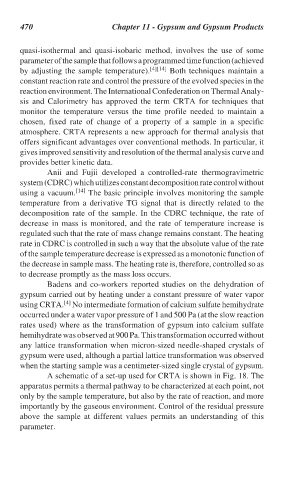Page 498 - Handbook of Thermal Analysis of Construction Materials
P. 498
470 Chapter 11 - Gypsum and Gypsum Products
quasi-isothermal and quasi-isobaric method, involves the use of some
parameter of the sample that follows a programmed time function (achieved
by adjusting the sample temperature). [4][14] Both techniques maintain a
constant reaction rate and control the pressure of the evolved species in the
reaction environment. The International Confederation on Thermal Analy-
sis and Calorimetry has approved the term CRTA for techniques that
monitor the temperature versus the time profile needed to maintain a
chosen, fixed rate of change of a property of a sample in a specific
atmosphere. CRTA represents a new approach for thermal analysis that
offers significant advantages over conventional methods. In particular, it
gives improved sensitivity and resolution of the thermal analysis curve and
provides better kinetic data.
Anii and Fujii developed a controlled-rate thermogravimetric
system (CDRC) which utilizes constant decomposition rate control without
using a vacuum. [14] The basic principle involves monitoring the sample
temperature from a derivative TG signal that is directly related to the
decomposition rate of the sample. In the CDRC technique, the rate of
decrease in mass is monitored, and the rate of temperature increase is
regulated such that the rate of mass change remains constant. The heating
rate in CDRC is controlled in such a way that the absolute value of the rate
of the sample temperature decrease is expressed as a monotonic function of
the decrease in sample mass. The heating rate is, therefore, controlled so as
to decrease promptly as the mass loss occurs.
Badens and co-workers reported studies on the dehydration of
gypsum carried out by heating under a constant pressure of water vapor
[4]
using CRTA. No intermediate formation of calcium sulfate hemihydrate
occurred under a water vapor pressure of 1 and 500 Pa (at the slow reaction
rates used) where as the transformation of gypsum into calcium sulfate
hemihydrate was observed at 900 Pa. This transformation occurred without
any lattice transformation when micron-sized needle-shaped crystals of
gypsum were used, although a partial lattice transformation was observed
when the starting sample was a centimeter-sized single crystal of gypsum.
A schematic of a set-up used for CRTA is shown in Fig. 18. The
apparatus permits a thermal pathway to be characterized at each point, not
only by the sample temperature, but also by the rate of reaction, and more
importantly by the gaseous environment. Control of the residual pressure
above the sample at different values permits an understanding of this
parameter.

